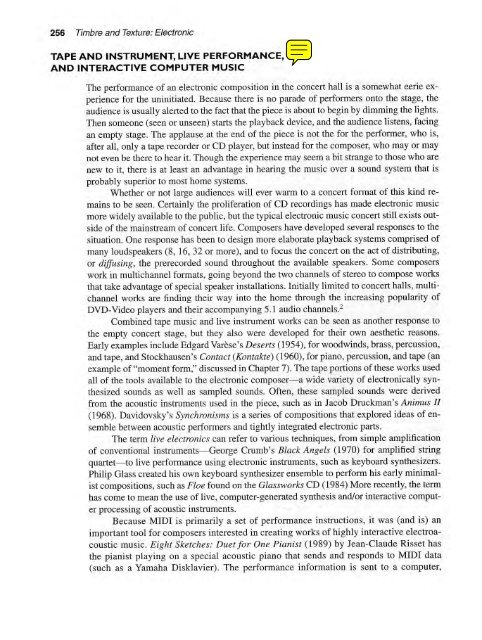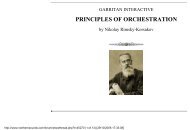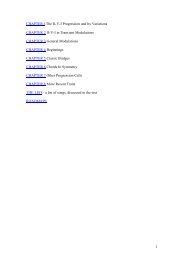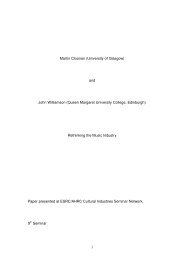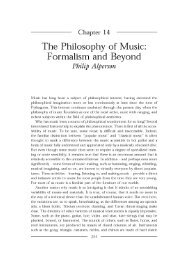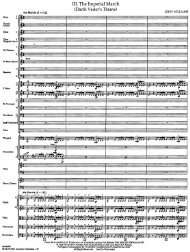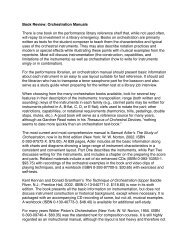TWENTIETH- - Synapse Music
TWENTIETH- - Synapse Music
TWENTIETH- - Synapse Music
Create successful ePaper yourself
Turn your PDF publications into a flip-book with our unique Google optimized e-Paper software.
256 Timbre and Texture: Electronic<br />
TAPE AND INSTRUMENT, LIVE PERFORMANCE,<br />
AND INTERACTIVE COMPUTER MUSIC<br />
The performance of an electronic composition in the concert hall is a somewhat eerie experience<br />
for the uninitiated. Because there is no parade of perfonners onto the stage, the<br />
audience is usually alerted to the fact that the piece is about to begin by dimming the lights.<br />
Then someone (seen or unseen) starts the playback device, and the audience listens, facing<br />
an empty stage. The applause at the end of the piece is not the for the performer, who is,<br />
after all, only a tape recorder or CD player, but instead for the composer, who mayor may<br />
not even be there to hear it. Though the experience may seem a bit strange to those who are<br />
new to it, there is at least an advantage in hearing the music over a sound system that is<br />
probably superior to most home systems.<br />
Whether or not large audiences will ever warm to a concert format of this kind remains<br />
to be seen. Certainly the proliferation of CD recordings has made electronic music<br />
more widely available to the public. but the typical electronic music concert sti ll exists outside<br />
of the mainstream of concert life. Composers have developed several responses to the<br />
situation. One response has been to design more elaborate playback systems comprised of<br />
many loudspeakers (8, 16, 32 or more), and to focus the concert on the act of distributing,<br />
or diffusing, the prerecorded sound throughout the available speakers. Some composers<br />
work in multichannel formats, going beyond the two channels of stereo to compose works<br />
that take advantage of special speaker installations. Initially li mited to concert halls, mulLichannel<br />
works are finding lheir way into the home th rough the increasing popularity of<br />
DVD-Video players and their accompanying 5.1 audio channels.'<br />
Combined tape music and live instrument works can be seen as another response to<br />
the empty concert stage, but thcy also were developed for their own aesthetic reasons.<br />
Early examples include Edgard Varese's Deserts (1954), for woodwinds, brass, percussion,<br />
and tape, and Stockbausen's Contact (Kontakte) (1960), for piano, percussion, and tape (an<br />
example of "moment form ," discussed in Chapter 7). The tape portions of these works used<br />
all of the tools available to the electronic composer-a wide variety of electronically synthesized<br />
sounds as well as sampled sounds. Often, these sampled sounds were derived<br />
from the acoustic instruments used in the piece. such as in Jacob Druckman's Animus II<br />
(1968). Davidovsky's Synchronisms is a series of compositions that explored ideas of ensemble<br />
between acoustic performers and tightly integrated electronic parts.<br />
The term live electronics can refer to various techniques, from simple amplification<br />
of conventional instruments- George Crumb's Black Angels (1970) for amplified string<br />
quartet- to live pelformance using electronic instruments, such as keyboard synthesizers.<br />
Philip Glass created his own keyboard synthesizer ensemble to perform his earl y minimalist<br />
compositions, such as Floe found on the Glassworks CD (1984) More recentl y, the term<br />
has come to mean the use of live, computer-generated synthesis andlor interactive computer<br />
processing of acoustic instruments.<br />
Because MIDI is primarily a set of performance instructions, it was (and is) an<br />
important tool for composers interested in creating works of highly interactive electroacoustic<br />
music. Eight Sketches: Duet for One Pianist (1989) by Jean-Claude Risset has<br />
the pi ani st playing on a special acoustic piano that sends and responds to MIDI data<br />
(such as a Yamaha Disklavier). The performance information is sent to a computer,


